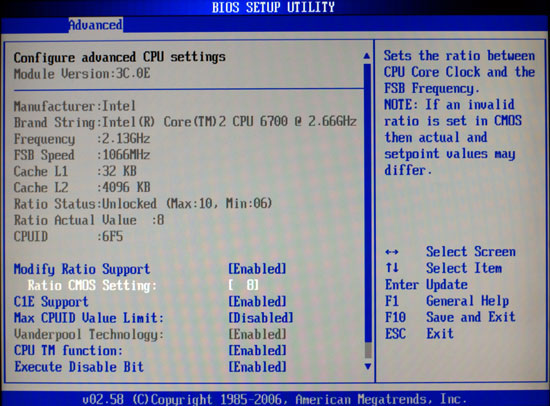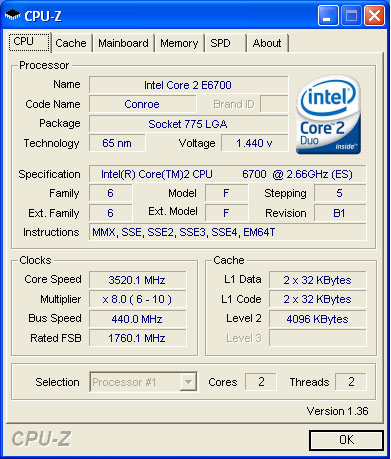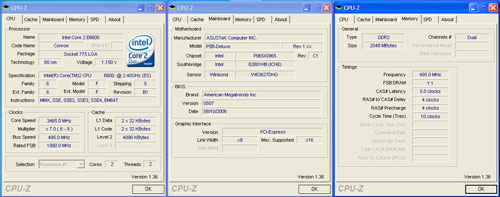ASUS P5B: New BIOS Adds Unlocking & Improved Overclocking
by Wesley Fink on August 24, 2006 3:00 PM EST- Posted in
- Motherboards
E6700
The 0507 BIOS adds a new feature in the BIOS under the "Advanced", "CPU Configuration" tab. Where there was no means to adjust CPU ratios in earlier BIOS versions, with 0507 you now have an adjustment range from 6X to 10X.

Some Conroe chips also unlock at the top, allowing ranges to about 14x. None of our Conroe chips unlocked up, but you may be one of the lucky ones who have a Conroe that unlocks both down and up.
The E6700, which runs at 2.67GHz, is very interesting because of the large headroom we consistently find at stock voltage. Once again, on the P5B Deluxe at stock voltage, the combo could run day and night at 3.4GHz (340x10) with no issues at all. At the stock multiplier of 10x, at 1.4875V the highest stable speed was 360x10 or 3.6GHz, At a reduced 9x the highest speed was 400x9, which is also 3.6GHz. With the new BIOS unlocking multipliers down, we reached 440 at 8x, or 3.52Ghz, as you can see in this screen capture.

7x allowed a further increase to a FSB speed of 494, which is where the 6700/P5B maxed out. Even at a 6X multiplier 494 seems the limit of the FSB with this CPU and board. Comparing this to our highest FSB overclock of 362 with this board in the Conroe Buying Guide we would conclude that ASUS has significantly improved the overclocking of the P5B. The ability to choose and hold lower multipliers allowed the bus speed to increase from 360 to 494.
E6600
The E6600 unlocked down with the new BIOS and allowed a new range of FSB adjustments of 405x9 (stock), 460x8, 495x7, and 495x6. Below is a screen capture at 495x7 or 3.465GHz.
While the new BIOS on the P5B adds enormous flexibility to the 965P motherboard, it should still be pointed out that on average the 965 still does not overclock as well as the Intel 975X if you compare clock to clock. You might want to look back at the 975X overclocking results in Conroe Buying Guide: Feeding the Monster for a comparison.
The 0507 BIOS adds a new feature in the BIOS under the "Advanced", "CPU Configuration" tab. Where there was no means to adjust CPU ratios in earlier BIOS versions, with 0507 you now have an adjustment range from 6X to 10X.

Some Conroe chips also unlock at the top, allowing ranges to about 14x. None of our Conroe chips unlocked up, but you may be one of the lucky ones who have a Conroe that unlocks both down and up.
The E6700, which runs at 2.67GHz, is very interesting because of the large headroom we consistently find at stock voltage. Once again, on the P5B Deluxe at stock voltage, the combo could run day and night at 3.4GHz (340x10) with no issues at all. At the stock multiplier of 10x, at 1.4875V the highest stable speed was 360x10 or 3.6GHz, At a reduced 9x the highest speed was 400x9, which is also 3.6GHz. With the new BIOS unlocking multipliers down, we reached 440 at 8x, or 3.52Ghz, as you can see in this screen capture.

7x allowed a further increase to a FSB speed of 494, which is where the 6700/P5B maxed out. Even at a 6X multiplier 494 seems the limit of the FSB with this CPU and board. Comparing this to our highest FSB overclock of 362 with this board in the Conroe Buying Guide we would conclude that ASUS has significantly improved the overclocking of the P5B. The ability to choose and hold lower multipliers allowed the bus speed to increase from 360 to 494.
E6600
The E6600 unlocked down with the new BIOS and allowed a new range of FSB adjustments of 405x9 (stock), 460x8, 495x7, and 495x6. Below is a screen capture at 495x7 or 3.465GHz.
 |
| Click to enlarge |
While the new BIOS on the P5B adds enormous flexibility to the 965P motherboard, it should still be pointed out that on average the 965 still does not overclock as well as the Intel 975X if you compare clock to clock. You might want to look back at the 975X overclocking results in Conroe Buying Guide: Feeding the Monster for a comparison.










84 Comments
View All Comments
BuddyHolly - Friday, August 25, 2006 - link
Thanks Wesley for the info on running the memory in spec. That is exactly what I was looking for.When I am asking for benchmarks, I would love to see PI and a few others run at the same clock speed but different FSB to show what gain we get from this..for example
The 6300 at the following:
7x429=3000
6x500=3000
What type of gain to we get from jacking up the front side bus? I know it used to help a lot on my old Barton's, but what does it get us with the Core 2?
Great article and interesting discussion. One of the things I truly love it the fact that the staff at AT respond to these post and realy add a lot to the discussion.
Thanks again!
BuddyHolly - Friday, August 25, 2006 - link
I have a few questions that were not covered1) Can we have some benchmarks showing the benefit of running up the FSB vs standard at the same clock speed. I know on some processors in the past this gave a nice boost in performance, but how much are we talking here? Huge gains or just a few percent?
2) Can we lock the memory on these boards and crank the FSB up with cheap memory? If so, what are the benifits the same?
Thanks for the article. I too got excited at seeing the title, hoping for a return to the golden days of overclocking without multiplier locks....
Wesley Fink - Friday, August 25, 2006 - link
DDR2-533 is the 1:1 strap and theoretically provides the highest memory bandwidth. DDR2-533 memory setting hits DDR2-800 at 400FSB. Almost all of the cheap memory based on Elpida chips can do DDR2-800 4-3-3 as you saw in the Conroe Buying Guide. At the highest multiplier of x7, then the E6300 maxes out at 2.8GHz, with plenty of headroom left.Dropping the memory to DDR2-400 you would reach DDR2-800 at a FSB of 533, which covers all the headroom we found with the E6300. You have even more flexibility with the E6400 with the higher x8 multiplier.
The point is you should be able to reach pretty high in headroom even with cheaper memory. Of course the high-end DDR2 all reached DDR2-1067 to DDR2-1100, which gives even more flexibility for maxing headroom at the fastest memory timings possible.
As for benchmarks, we provided Super Pi times in several of the higher overclocks as a quick bench, You can easily compare these results to what you achieve. Super Pi is a free program that's easy to run. Version 1.5 is a modified version for benchmarking available at xtremesystems.org.
shabby - Saturday, August 26, 2006 - link
So the p5b has a ddr2-400 setting? I thought the lowest was a 1:1 ratio(533 setting).Gary Key - Saturday, August 26, 2006 - link
If you are using a P4 then the DDR2-400 setting is the base setting on this board.
shabby - Sunday, August 27, 2006 - link
And if its a c2d then your outta luck?kmmatney - Friday, August 25, 2006 - link
We are talking about some pretty huge gains here. Just look at the new speeds, and waht the equivalent cpu would cost running at those speeds. You gain the same performance of cpu's which can cost hundreds of dollars more.I agree wiuth your second question. I would like to see how things work out using a memory divider (do Conroe motherboards even use memory dividers?).
KHysiek - Friday, August 25, 2006 - link
In "Conroe Buying Guide: Feeding the Monster" Deluxe model was featured, here we have (I suppose) P5B regular. P5B non-dlx have less overclocking options (lika limited memory voltages), this have serious impact on o/c possibilities.In new BIOS we stilla have just 2.1 DDR2 max voltage?
junior1 - Friday, August 25, 2006 - link
New records for FSB is interesting, but I think the question that many of us have is: Is there an opportunity for getting more bang for the buck?Assuming that upwards unlocked chips are rare, the budget-constrained conroe buyer can
a.) Crank a cheaper CPU to high FSB, with expensive RAM and motherboard. Drop the multiplier if needed to take the system to its top performance, or
b.) Save money by buying value RAM and a mid-range motherboard, and spend that extra budget on a CPU with a higher max multiplier. The max FSB will not be so exciting, and the memory may have to run at a slower ratio, but the CPU core should be quite high.
Which of these two schools of thought will perform the best for the price? Of course it will vary on a case-by-case basis, but an investigation would be very relevant.
My guess is that the $300 or so required to get a high FSB mobo and fancy RAM would be better spent on a higher multiplier. Does anyone have any thoughts on this?
(Finally, I would also like to throw in my request for a review of the Gigabyte P965-DS3, as it seems to be the cheapest available Core2 motherboard with real OC potential.)
Janooo - Friday, August 25, 2006 - link
That's very good question. An answer would depend on what is your box meant for.It appears though that most of the applications are more "memory hungry" than CPU limited. That's why FSB speed is very important to overclockers.